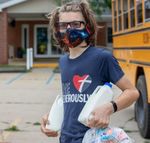Child Food Insecurity in New York City: An Action Plan - No Kid Hungry
←
→
Page content transcription
If your browser does not render page correctly, please read the page content below
Dear New York City Official,
Children in all five boroughs of New York City are growing up facing hunger. Since the COVID-19
pandemic, the number of children living with food insecurity has grown significantly, especially within
Black and Latino communities. Hunger takes a profound toll on children’s health, happiness, and their
ability to build successful futures and break the cycle of poverty.
Childhood hunger is, however, a solvable problem. As an elected leader in New York City, you
have the power to help and, together, we can ensure that all children get the nutrition they
need to grow up healthy, educated and strong.
With your leadership, we can:
❑ Enact bold strategies that provide better access to meal programs
❑ Promote innovative solutions to remove barriers so that children in low-income families can
access nutrition programs
❑ Advocate for critical policy changes to ensure thousands more children in need across the
five boroughs are receiving healthy meals every day
❑ Develop, share and implement a replicable “blueprint” for ending childhood hunger.
As a leader in New York City, you are on the front lines of this crisis. You can transform an issue into a
movement. With collaborative guidance, you can use your role to raise awareness about childhood
hunger, advance proven solutions and institute policies that bring about lasting changes to increase
access to child nutrition programs and end childhood hunger.
This year, No Kid Hungry New York is focused on relief and solutions during this crisis. In the midst
of the pandemic, 1 in 4 kids in New York City could face hunger. With the economic effects of the
COVID-19 crisis continuing to be felt across the city, it is more important than ever to remove barriers
that impede access to these nutrition programs as well as engage in outreach efforts to newly eligible
families.
We look forward to being your partner throughout this journey,
Rachel Sabella
Director
No Kid Hungry New YorkThe Problem: Childhood Hunger in New York
City
Food insecurity looks different in every household. For some families, the pantry is completely
empty. In others, parents skip dinner a few nights a week so their kids can have something to eat in
the evening. No matter how food insecurity manifests, much is at stake for these children, families
and the communities where they live. When kids don’t get the consistent nutrition they need each
day throughout the year, it’s harder for them to grow up healthy, educated and strong. Consistent
access to nutrition is linked to cognitive and physical development, better long-term health, higher
test scores and better education outcomes.
Unfortunately, the COVID-19 pandemic has exacerbated existing deep-rooted disparities,
increasing the severity of myriad health and economic crises and pushing millions more families
into poverty and hunger throughout the country. In New York City, the new reality created by the
pandemic has made it harder for children to access no-cost meals provided by schools and
community organizations. As a result, an estimated 1 in 4 kids in New York City may face
hunger.1
COVID-19: Impact on Child
Food Insecurity
In 2021,
1 in 4 kids
are projected to face hunger in
New York City.1
2021 Projected Child Food
Insecurity by Borough1
Bronx 36%
Brooklyn 28%
Manhattan 20%
Queens 22%
Staten Island 19%
New York City Total 26%End Childhood Hunger: Background and Action List for New York City Leaders School Meals For many children, school meals are their only source of consistent nutrition. The importance of school meals has never been more apparent than when school buildings closed for classroom learning in the spring of 2020 due to the pandemic. Over the years, the New York City Department of Education has expanded access to school meals by implementing Breakfast After the Bell programs in select schools and offering no-cost breakfast and lunch to all students. Opportunities: ❑ Ensure full implementation of Breakfast After the Bell programs in all New York City public schools. ❑ Support increased funding for school kitchen capital projects and resources to protect school cafeteria staff members. ❑ Support efforts to provide culturally appropriate food as part of the school meal programs. ❑ Advocate to federal elected officials for improvements to school meal programs through Child Nutrition Reauthorization. Emergency Food Network Food pantries and soup kitchens are often the last line of defense against hunger for many families. Many emergency food providers across the city have been forced to close their doors and those that are able to stay open are seeing an overwhelming number of clients. We have also seen other community based organizations create pantries, distribute fresh food boxes or take on other ways to address the increasing need for food by their clients. Opportunities: ❑ Increase baselined funding to the Emergency Food Assistance Program (EFAP). ❑ Increase the number of school pantries in the New York City public schools.
End Childhood Hunger: Background and Action
List for New York City Leaders
SNAP, WIC, P-EBT
The Supplemental Nutrition Assistance Program (SNAP) is one of the most effective and efficient
ways to ensure that kids and families have the support they need to purchase food. The Women,
Infants, and Children (WIC) program provides nutrition support to women and children up to five years
of age. Pandemic EBT (P-EBT) provides grocery assistance directly to households with children
eligible for free and reduced-price school meals when schools are closed or when there are
disruptions to the regular school day.
Opportunities:
❑ Increase funding for outreach and application assistance services.
❑ Reduce administrative burdens by streamlining SNAP enrollment with other support programs and
enhancing participant experience.
❑ Support efforts to ensure that mothers and young children have access to WIC and child care.
❑ Promote P-EBT and provide clear information to eligible families about how to participate.
❑ Advocate for federal policy change to increase SNAP benefits.
Across All Programs
Opportunities:
❑ Support efforts to pass equitable and inclusive city policies that will improve access to programs
including school meals, afterschool meals, summer meals programs, and SNAP.
❑ Ensure city agencies have the resources to efficiently administer and promote each program and
hold them accountable for reaching quantitative goals to increase program participation.
❑ Use your platform to celebrate the champions who are feeding kids and families through child
nutrition and other safety net programs.
❑ Raise awareness by speaking publicly about the issue of childhood hunger, using social media to
promote programs and program sites to constituents, and talk to school administrators and staff
about how child hunger impacts their students.About No Kid Hungry New York
Throughout the pandemic, No Kid Hungry New York has been working with schools, community
organizations, and families to keep kids from sliding into hunger. Through a combination of
emergency grants, strategic assistance, advocacy, and awareness-building, No Kid Hungry New
York is helping kids, families, and communities across the New York City get the resources they
need.
Since the pandemic began, our team has:
▪ Provided over $1.1 million in grant support for schools and community organizations in New
York City as well as $300,000 in Puerto Rico.
▪ Launched a texting line where families in New York City can text “NYC FOOD” or “NYC
COMIDA” to 877-877 to find the nearest NYC Department of Education Meal Hub.
▪ Raised awareness for school nutrition programs like Meal Hubs and Pandemic EBT.
No Kid Hungry New York extends our gratitude to everyone on the frontlines ensuring that kids don’t
go hungry during this crisis. Thank you to all who are working through these unprecedented times.
We appreciate you!
CONTACT STAY IN TOUCH GET CONNECTED
Rachel Sabella Visit the No Kid Hungry New Connect with our social
Director York website: channels:
No Kid Hungry New York https://state.nokidhungry.org/ Twitter: @NoKidHungryNY
rsabella@strength.org new-york/ Instagram: @NoKidHungryNY
Reference
1. The Impact of Coronavirus on Food Insecurity, Feeding America, March 31 2021,
https://www.feedingamerica.org/research/coronavirus-hunger-research/You can also read


























































